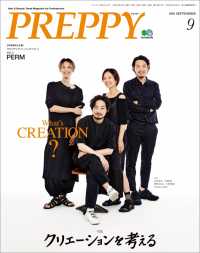- ホーム
- > 洋書
- > 英文書
- > Cinema / Film
Full Description
The late 1960s and 1970s are widely recognized as a golden age for American film, as directors like Francis Ford Coppola, George Lucas, and Martin Scorsese expanded the Hollywood model with aesthetically innovative works. As this groundbreaking new study reveals, those filmmakers were blessed with more than just visionary eyes; Designing Sound focuses on how those filmmakers also had keen ears that enabled them to perceive new possibilities for cinematic sound design. Offering detailed case studies of key films and filmmakers, Jay Beck explores how sound design was central to the era's experimentation with new modes of cinematic storytelling. He demonstrates how sound was key to many directors' signature aesthetics, from the overlapping dialogue that contributes to Robert Altman's naturalism to the wordless interludes at the heart of Terrence Malick's lyricism. Yet the book also examines sound design as a collaborative process, one where certain key directors ceded authority to sound technicians who offered significant creative input. Designing Sound provides readers with a fresh take on a much-studied era in American film, giving a new appreciation of how artistry emerged from a period of rapid industrial and technological change. Filled with rich behind-the-scenes details, the book vividly conveys how sound practices developed by 1970s filmmakers changed the course of American cinema.
Contents
Acknowledgments1 Introduction: The State of the ArtPart One General Trends (1965-1971)2 The British Invasion3 TV and Documentary's Influence on Sound Aesthetics4 New Voices and Personal Sound Aesthetics, 1970-1971Part Two Director Case Studies (1968-1976)5 Francis Ford Coppola: American Zoetrope and Collective Filmmaking6 Robert Altman's Collaborative Sound Work7 Martin Scorsese's Dialectical SoundPart Three The Dolby Stereo Era (1975-1980)8 The Sound of Music: Dolby Stereo and Music in the New American Cinema9 The Sound of Spectacle: Dolby Stereo and the New Classicism10 The Sound of Storytelling: Dolby Stereo and the Art of Sound DesignNotesBibliographyIndex
-

- 電子書籍
- RCmagazine 2024年12月号
-

- 電子書籍
- 再召喚された勇者は一般人として生きてい…
-

- 電子書籍
- 聖女の魔力は万能です 9 FLOS C…
-

- 電子書籍
- すべて俺の思い通り【タテヨミ】第77話…
-

- 電子書籍
- PREPPY 2018年9月号



